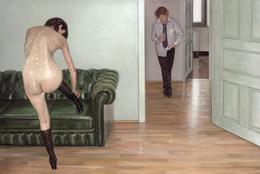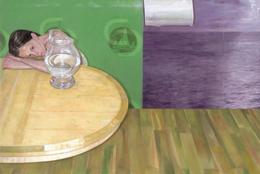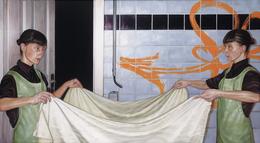Hidden images of the inexpressible
In this text describes Dr. Peter Schlueter the image and the search behind the image on several examples of Leipzig painter Aris Kalaizis. Besides, there originate worth reading observations and image-analyses
Excerpt from the everyday life of two people: A pensive man is intently pondering some subject. He is not alone. In the front room an almost naked woman. Her face is turned away. Only her boots cover a part of her body. It is not clear whether she is in the process of dressing or undressing. The man ignores her. Leaning against the wall, holding a glass in his hand, he is contemplative and slumped together. The relationship between these two people remains unclear, whether there was or is a relationship, and even more unclear what meaning the painting "The English Room," created in 2004, should have.
…is the world of dreams which he portrays with extremely austere means
Paradigmatically, this painting does not only refuse to allow a quick understanding, but also rejects any monopolization concerning human contexts. Therefore, it is not surprising that Aris Kalaizis' figures almost always exhibit a strong self-adsorption, incapable of looking outward. It is a quiet world in which almost everything happens just as in real life, in which the people are almost real people, in which almost everything is natural, in which one is not supposed to ask too many questions – we know this world: it is the world of dreams which he portrays with extremely austere means. The objects in Kalaizis' picture world are characterized by an aura of formal clarity, increasing silence but also of ecstasy. As is generally true for this painter, the process of familiarizing oneself with his direct environment is a process of finding oneself personally. It would thus appear to be promising to first take a closer look at the biography of this relatively young painting career.

Generally speaking one might first maintain that Kalaizis' life as up to now has been characterized by extraordinary constancy and appears to have been free of any larger excitements.
In 1966 he was born in Leipzig as the son of political emigrants from Greece. Interestingly, he grew up in the west of Leipzig on a street that was named after a painter: Lucas Cranach. His parents fleeing the Greek Civil War 1948⁄49 moved to the area, which at the time was a Soviet occupied zone. Growing up in a rather narrow-minded era, he first came to feel that he was different due to the cultural background of his parents, which might explain his early introvertedness. The insistence and decisiveness of his current paintings might well stem from this introversion. The introvertedness of his earlier days appears to have vanished, yet his consistent insistence has remained. The entirely personal character of this process is reflected in Kalaizis' statement: "…The more I became a painter, the easier it was for me to approach people, since there is perhaps no lonelier activity than concentrated painting." And he is not a nomadic painter, who offers for sale the foreign oddities he has dragged home. He remains, in accordance with his character, a settled type of painter, even though in the coming year he will take up a work scholarship in the USA. It can be implied that this settledness is a character trait which does not hinder the patient and concentrated developing of compositions.
…Kalaizis' paintings are a private journal, a kind of coded recording of his thoughts
Even before studying painting at the Leipzig Academy under Prof. Arno Rink, whose master-class student he became in 2001, he was interested in photography. Only later did he develop an interest in films. And, in fact, Kalaizis admits that for him the cinema is "…a pleasant shelter for my journey. There I try to find small utopias, which can put me in a state of amazement." Even though it appears that in his latest paintings he remembers certain film shots, it is always clear how decisively he acts as a painter. Both arts forms interest him insofar as they serve to assist his painting. Kalaizis does not paint according to drawings, but rather writes a script like a screenwriter. One is tempted to say that this writing is Kalaizis private journal, a kind of coded recording of his thoughts, a view which studies the view, the eye of the artist, which observes that which the eyes of the artist catch. All of the objects, all of the figures which we finally see in his paintings are creations which result from the act recording in writing. The act of writing of is, thus, a phase of his contemplation. Certainly, an element of doubt is embedded in this attitude: approaching nature by the act of drawing. After finishing his script Kalaizis does not follow only a single photograph, but has been increasingly following several photographs taken by himself, which differentiates him from the photorealists, who do not challenge the observer with a new reality. He does not strive to copy nature completely, rather his painting selects from an imaginative reality. With extreme precision he feels the weight and the unpredictability of objects, the elements of nature and the body, and he allows these components to be felt. Thus, his reality is nurtured on the one hand by his precision of seeing, and on the other hand it uses the creative strength of dreams.
A revitalizing course arises as a result and it follows that Kalaizis sees the task to be solved in the process of invention rather than in imitation. An artist who wants to represent a real or an imaginary object does not only begin by opening his eyes, but rather by searching for colors and shapes with which he can construct this object. We would fail to recognize the true character of his picture world, if we were to label his very detailed execution as an "imitation." In his paintings the manifestation of his vision takes absolute precedence over the reproduction of the objects themselves. And this does not so much concern observation as it does a tireless process of experimentation.
We know Plato rejected the art of his time since the artist does not evoke real objects but rather illusory objects, in other words, nothing but dreams and illusions. He thus compared the artist with a Sophist who deludes his audience by representing components which do not correspond with the real world. Plato continues by arguing that the similarities that the artist creates are only products of our imagination. We can say that Plato was aware of the close connection between the imagination of the artist and that of the audience, yet he misunderstood that the content of the new artistic creation gives birth to a new reality, since it soon began to be recognized that painting not only opens a window to the visible world, but also serves as an instrument to unlock inner worlds.
…in the depths of our psyche for the unexpressed and inexpressible
However, this resulted in the fact that from then on even the slightest interpretation of pictures required an intellectual approach. Of course even a painting such as Kalaizis' "Brancard" (2004) utilizes all of the artistic techniques such as light, perspective and so on, but not in order to create a harmonic effect, but rather to lead it into a condition of unsolved and unsolvable conflicts. The explosion in the upper corner of the painting is only intimated and is casually presented. Between the guiding flower, a frequently appearing motif, and the inferno we find an encoded woman. Seemingly unaffected by the occurrences, she climbs up the stairs, carrying a handbag. And this is where Kalaizis' paintings speak to us, like a hidden image or a picture puzzle, which challenge our entire astuteness and force us to search from within the depths of our psyche for the unexpressed and inexpressible. In this way Kalaizis' paintings might reveal their secret. Their sense is only slightly touched through our senses, only intimated. An example, such as listening to static-filled recordings, might illustrate how an attempt at interpretation is able to irreversibly change that which was actually heard.

In the paintings "Die Lichtung" / Enlightenment (2004) and "Ocean" (2004) in which Kalaizis painted his nine-year-old daughter Nike, the colors of the paintings evoke coldness and loneliness in us, yet upon longer observation it appears behind the melancholic mood that hope is approaching. In these paintings everything seems to be rigid, and nothing seems to be moving. The picture "Ocean," however appears to be like a painted program. The girl dreams with open eyes, fully conscious. These paintings are sweet and at the same time serious, like the grace of a loving caress, like the silence between the thoughtful little girl and the painter, who observes her – astonished, surrendered, with complete affability. And: The new discovery also comprises shifting the entire color range, lightening the palette. In almost all of his works we are confronted with similar figures. We also encounter the woman with the mysterious leather bag, the orange head scarf, and the sunglasses on several of his paintings. Behind the façade of this figure is hidden Annett, the wife of the painter, who has often posed for her husband. We can assume that the last panel of the four-part picture series "The Ideal Crash" from 2002/2003 served as the starting point for the continuing integration of this particular female character. Her constant introversion is characterized by perpetual elegance and style. But she also shows an erotic charge which never seems to discharge. This figure is typical for Kalaizis' characteristic play of revealing and concealing, showing and veiling, his own dialectics of indicating and leaving out.
…the dual nature of human beings. His heroes and antiheroes are sinners and saints in the same person
The new paintings have several further design characteristics in common, which differ from the stage-like composed works of his earlier period. In painting, as well as in music or poetry, variation is a pleasure which in itself serves the creative spirit. The practice of variation is also a game which takes freedom by putting limits on itself. On the one hand, there is the painted reoccurrence of the cliched ship symbolism, the flower, the often similar composition of the background architecture as well as the continual reappearance of the female character as has already been described. We can say that although Kalaizis takes pleasure in frequently drawing upon his picture inventory, it remains vital that this wealth of ideas never becomes ornamental, but always serves the purpose of integration. Although Kalaizis has bound himself to a strict rule, at the same time he discovers the possibilities of his invention, the unexpected fruits of this combining, which result from constancy.
In the painting "Die doppelte Frau" / Woman in Double (2004) the same person even encounters herself. In this painting that which could only be assumed in his earlier paintings becomes even clearer: The dual nature of human beings. His heroes and antiheroes are sinners and saints in the same person, just as he himself seems to possess contradictory characteristics.

Furthermore, we find the sudden, not rationally explicable encounter of opposing worlds. The painting "Der Ausflug" / The Excursion, 2004, which was composed from the most differing levels of reality also leads to an ambivalence, which unifies the differing perspectives of the same magnitude. One might even argue that with the necessary imagination an endless number of interpretations becomes possible. Perhaps this situation originates from inner tension within the artist. In 1997 Kalaizis had already stated in a discussion with the sociologist Jan Siegt: "The situation of conflict is part of my nature, since when it comes down to it I go back and forth between polarities. I could never develop a passion resulting from a rejection of existence, which also plays a role, nor could I offer my unlimited affirmation of existence."
While the earlier paintings strove to harmonize the polaric elements in the series, today we are confronted by a metaphysical approach to the classic panel painting.
The paintings "Die doppelte Frau" or "Die Lichtung" are furthermore characterized by a complex relationship of light and darkness. On the one hand this means of composition serves the structure of formal tensions, while on the other hand it serves to entangle the observer in allusions. The half-open doors, behind which we can assume there is nothing but darkness, create a kind of limbo. The darkness refers to a spiritual presence of the non-present.
And it is the same ambivalence of the present and non-present which could already be found in earlier paintings such as "Fargo" (2002). Of course the artist shows here that he was aware of the close connection between his imagination and that of the observer. In other words: Only works which were created in a state of heightened imagination are able to appeal to our imagination – where there is nothing, nothing can arise. Certainly, this requires that the skill of the painter to indicate cooperates with the ability of the observer to understand these indications.
…the benevolent observer makes the effort to meet Kalaizis' hints halfway, since the experience of transformation always brings an element of pleasure
And: If we take a closer look at past few years of the 37-year-old painter, we are confronted with surprises again and again. In the past he created a series of assemblages on the surface used wooden pallets, which makes us even more surprised by a current subject: the landscape. If we refer to Kalaizis' previous statement, both representations do not contradict each other, since in both forms a struggle for abstraction becomes present. While the assemblages from 2003 were only gradually constructed and arranged upon the medium, the landscape pictures "Waldstück Köhra I‑III" / Woodland Köhra I‑III are characterized by a gradual reduction and taking away. Thus, both genres use differing approaches as a basis, yet they connect with each other at a point of mutual striving toward clarity and simplification in color and shape. Oddly enough Kalaizis painted the landscape of his triptych in such a manner that he almost spared the deeper dimensions.
Beforehand we argued that he offers the figures in his paintings a broader room, yet we can observe an opposing tendency in his landscapes, which inevitably leads to a flatter composition. If we look at the whole matter from an analytical perspective, we can realize that in these small landscapes light and heavy shapes influence each other and in this way create a characteristic and exciting opposition.
Yet, if we concentrate on the most recent paintings that Aris Kalaizis produced, we can realize that the increasing discovery of the composition of space becomes obvious. While in his earlier paintings the human figure was in the center of his composition, today the individual recedes behind the carefully designed architecture. The center as a crystallization point of composition, as has been mentioned before, seems to make way for the polycentric. Just as in the earlier Fargo paintings, the painting "Die Nacht stirbt vor der Stille" (2004) / Before the Silence Dies the Night refers to something which is beyond the outline of the painting. And although this painting appears to be untypical with regard to its absence of strict compositional rules, it nevertheless serves to act like a program, since even this painting does not possess an fast anchorage. It would only provoke our spirit, so to speak. And it becomes apparent that Kalaizis' paintings can be interpreted in a manifold manner. However, this ambiguity cannot be perceived directly as such, since we can only understand it by learning to switch from one interpretation to another. It is just because he allows the observer more and more of his own freedom, that he is able to pull the observer into the magic circle of his creation and enables him to experience some of the joy of creation. The benevolent observer makes the effort to meet Kalaizis' hints halfway, since the experience of transformation always brings an element of pleasure.
©2005 Peter Schlüter | Aris Kalaizis
Dr. Peter Schlüter is a freelance journalist. He is living in Berlin and Amsterdam